Heritage Protection Perspective of Sustainable Development of Traditional Villages in Guangxi, China
Abstract
1. Introduction
1.1. Background
1.2. Literature Review
2. Methods
2.1. Study Area
2.2. Data Source
2.3. Methods
2.3.1. Field Investigation
2.3.2. Interview and Questionnaire Survey
2.3.3. Index Screening
2.3.4. Index System Construction
2.3.5. Expert Consultation
2.3.6. Weight Determination and Scoring Criteria
3. Results
3.1. Index Weight Value Analysis
3.2. Evaluation Results
3.2.1. Living Space Evaluation
3.2.2. Production Space Evaluation
3.2.3. Ecological Space Evaluation
3.3. Results Summary
4. Discussion
4.1. Analysis of the Heritage Value of Traditional Villages in Guangxi
4.1.1. Heritage Element Analysis
4.1.2. Heritage Space Value
4.2. Spatial Sustainable Development Strategy of Traditional Villages in Guangxi
4.2.1. Space Enhancement, Cluster Development Strategy
4.2.2. Spatial Integration, Complementary Development Strategy
4.2.3. Spatial Reconstruction, Symbiotic Development Strategy
5. Conclusions
Author Contributions
Funding
Institutional Review Board Statement
Informed Consent Statement
Data Availability Statement
Acknowledgments
Conflicts of Interest
Appendix A
| Layer B | Layer C | Layer D | Description of Factors | ||||
|---|---|---|---|---|---|---|---|
| Living space B1 | Traditional Building C1 | D1 Terrain Slope (°) | [0, 5) | [5, 10] | (10, 15] | (15, 25] | >25 |
| D2 Age (year) | >200 | (100–200] | (50, 100] | (30, 50] | [0, 30) | ||
| D3 Artifact scarcity | >5 | (3, 5] | (2, 3] | [1, 2] | [0, 1) | ||
| D4 Land size (ha) | >5 | (3, 5] | (2, 3] | [1, 2] | [0, 1) | ||
| D5 Occupation ratio (%) | >60 | (40, 60] | (20, 40] | [10, 20] | [0, 10) | ||
| D6 The richness of architectural functions | >5 | (3, 5] | (2, 3] | [1, 2] | [0, 1) | ||
| Road/street C2 | D7 Street intersection distance (m) | (20, 40] | [0, 20] | (40, 60] | (60, 100] | >100 | |
| D8 Street width (m) | >6 | (4, 6] | (2, 4] | [1, 2] | [0, 1) | ||
| D9 Road area per capita (m²) | >10 | (5, 10] | (3, 5] | [2, 3] | [0, 2) | ||
| Entertainment plaza C3 | D10 Number of squares | >10 | (7, 10] | (4, 7] | [1, 4] | [0, 1) | |
| D11 Kind of plaza | >7 | (5, 7] | (3, 5] | (2, 3] | [0, 2) | ||
| D12 Public parking spaces (people/one) | [0, 1] | (1, 3] | (3, 5] | (5, 10] | >10 | ||
| D13 Age of history (year) | >100 | (50, 100] | (30, 50] | [10, 30] | [0, 10) | ||
| Green landscape C4 | D14 Open area (%) | (80, 100] | (80, 100] | (50, 80] | (0, 50] | 0 | |
| D15 Convenience (m) | [0, 100] | (100, 200] | (200, 300] | (300, 400] | >400 | ||
| D16 Native plant species | >6 | (4, 6] | (2, 4] | [1, 2] | 0 | ||
| D17 Local integration ability | strongest | strong | moderate | weak | poor | ||
| Emergency disaster prevention C5 | D18 Disaster prevention distance | >500 | (350, 500] | (250, 350] | [100, 250] | [0, 100) | |
| D19 Types of drainage facilities | >6 | (4, 6] | (2, 4] | [1, 2] | 0 | ||
| D20 Flood control emergency number | >10 | (6, 10] | (2, 5] | [1, 2] | 0 | ||
| D21 Coverage of firefighting facilities (%) | 100 | (80, 100] | (60, 80] | [20, 60] | [0, 20) | ||
| Public service C6 | D22 Walking service radius (minutes) | [0, 3] | (3, 5] | (5, 10] | (10, 15] | >15 | |
| D23 Satisfaction of living facilities | best | better | well | bad | worse | ||
| D24 Happiness perception (%) | (80, 100] | (60, 80] | (40, 60] | [20, 40] | [0, 20) | ||
| D25 Types of special services | >10 | (5, 10] | (3, 5] | (1, 3] | [0, 1] | ||
| Cultural Heritage C7 | D26 Number of heritage types | >5 | (4, 5] | (2, 3] | (1, 2] | [0, 1] | |
| D27 Inheritance time (year) | >200 | (100, 200] | (50, 100] | [30, 50] | [0, 30) | ||
| D28 Proportion of participants in large-scale folk activities (%) | >70 | (50, 70] | (25, 50] | [10, 25] | [0, 10) | ||
| D29 Folklore events attract tourist numbers | >50,000 | (20,000, 50,000] | (5000, 10,000] | [1000, 5000] | [0, 1000) | ||
| Historical Events C8 | D30 Number of major historical events | >4 | (3, 4] | (2, 3] | [1, 2] | [0, 1) | |
| D31 Number of famous people in history | >5 | (3, 5] | (2, 3] | [1, 2] | [0, 1) | ||
| D32 Degree of spreading the word | Be active | persistence | weakness | degradation | none | ||
| Production space B2 | Production environment C9 | D33 Soil texture | Red purple soil | Brown Shan soil | Yellow Shan soil | Silt sand | Blue mud field |
| D34 Terrain slope (°) | [0, 2] | (2, 6] | (6, 15] | (15, 25] | >25 | ||
| D35 Irrigation distance | (0, 100] | (100, 150] | (150, 200] | (200, 250] | >250 | ||
| D36 Production form | Diversified production | Modernized production of companies | Modernized production of company | Modernized production of groups | Individual production | ||
| Heritage Development C10 | D37 Primary production type (agriculture, forestry, fishing, animal husbandry, and gathering) | >6 | (4, 6] | (2, 4] | (0, 2] | 0 | |
| D38 Heritage Resources | most | many | moderate | less | none | ||
| D39 Types of Heritage Development Projects | >5 | (3, 5] | (2, 3] | (1, 2] | (0, 1] | ||
| D40 Number of production heritage items | >10 | (8, 10] | (5, 8] | [3, 5] | [0, 3) | ||
| Economic Industry C11 | D41 The proportion of secondary and tertiary industries (%) | >60 | (40, 60] | (10, 40] | (0, 10] | 0 | |
| D42 GDP growth rate per capita (%) | >7 | (5, 7] | (3, 5] | (1, 3] | [0, 1] | ||
| D43 Population return growth rate (%) | >20 | (10, 20] | (5, 10] | (0, 5] | 0 | ||
| D44 The employment rate of villagers (%) | 100 | (80, 100) | (50, 80] | [20, 50] | [0, 20) | ||
| Ecological Space B3 | Natural Landscape C12 | D45 Number of ancient and famous trees | most | many | moderate | few | none |
| D46 Forest cover rate (%) | >80 | (60, 80] | (40, 60] | [20, 40] | [0, 20) | ||
| D47 Terrain slope (°) | <5 | (5, 15] | (15, 25] | (25, 35] | >35 | ||
| D48 Landscape type (landscape, forest, farmland, lake, grass, and sea) | >7 | (5, 7] | (3, 5] | (1, 3] | [0, 1] | ||
| D49 The proportion of ecological land | >90 | (80, 90] | (60, 80] | [50, 60] | [0, 50) | ||
| D50 Grade of water quality | I | II | III | IV | V | ||
| Cultural Landscape C13 | D51 Historical landmark | >5 | (4, 5] | (2, 3] | (1, 2] | [0, 1] | |
| D52 Garden monuments | >5 | (4, 5] | (2, 3] | (1, 2] | [0, 1] | ||
| D53 Water Conservancy Scenic Area | National-level | provincial-level | Municipal-level | County-level | none | ||
| D54 Scenic Area | National-level | provincial-level | Municipal-level | County-level | none | ||
| D55 Nature Reserve | National-level | provincial-level | Municipal-level | County-level | none | ||
| Fix governance C14 | D56 Garbage disposal rate (%) | >90 | (70, 90] | (30, 70] | [10, 30] | [0, 10) | |
| D57 Public participation rate | strongest | strong | moderate | weak | none | ||
| D58 Ecological service level | highest | high | moderate | weak | none | ||
| D59 Renewable energy usage (%) | 100 | (80, 100] | (50, 80] | (0, 50] | 0 | ||
References
- Huang, Y.C.; Xu, S.L. Analysis of traditional village layout form from the perspective of ecological landscape schema. Planner 2018, 34, 139–144. [Google Scholar]
- Tang, Y.P. Research on the protection planning of traditional villages based on the cognition of heritage value, taking Diaoyuan Village as an example. Agric. Coogie 2021, 3, 263–271. [Google Scholar]
- Zhang, H.L.; Chen, J.; Zhou, C.S. Review and Prospect of Chinese Traditional Village Studies. City Plan. 2017, 41, 74–80. [Google Scholar]
- Pang, J. Local memory and village public space construction in the process of urbanization: Take Guangxi Zhuang villages as an example. Guizhou Ethnic Stud. 2016, 37, 60–63. [Google Scholar]
- Bian, J.J.; Chen, W.X.; Zeng, J. Spatial Distribution Characteristics and Influencing Factors of Traditional Villages in China. Int. J. Environ. Res. Public Health 2022, 19, 4627. [Google Scholar] [CrossRef]
- Li, W.H.; Lu, K.R. Research on the integration, sharing and co-construction mechanism of traditional village value living inheritance and rural revitalization. Fujian Forum 2019, 8, 187–195. [Google Scholar]
- Li, Y. Research on the Composition and Living Protection of Traditional Village Landscape; Chongqing University: Chongqing, China, 2018. [Google Scholar]
- Jin, G. Research on the mode innovation of financial support for Guangxi village tourism development under the rural revitalization strategy. Chin. Bus. Theory 2020, 5, 196–197. [Google Scholar]
- Jin, J.J. Cultural Geography of Traditional Villages and Folk Houses in Guangxi; South China University of Technology: Guangzhou, China, 2020. [Google Scholar]
- Nicholas, L.N.; Thapa, B.; Ko, Y.J. Residents’perspectives of a World Heritage Site: The Pitons Management Area, St. Lucia. Ann. Tour. Res. 2009, 36, 390–412. [Google Scholar]
- Song, H.; Zhu, C.; Fong, L.H.N. Exploring Residents’ Perceptions and Attitudes towards Sustainable Tourism Development in Traditional Villages: The Lens of Stakeholder Theory. Sustainability 2021, 13, 13032. [Google Scholar] [CrossRef]
- Sun, J. Architect’s Tradition and Iconoclast. Shanxi Archit. 2013, 39, 36–37. [Google Scholar]
- Li, Z.Y. Research on the Evolution of Rural Physical Environment in Guilin Area. Ph.D. Thesis, South China University of Technology, Guangzhou, China, 2012. [Google Scholar]
- Chang, K.; Chou, P. Integrating Intelligent Living, Production and Disaster Prevention into a Sustainable Community Assessment System for the Rural Village Regeneration in Taiwan, 2011 International Conference on Multimedia Technology, Hangzhou, China, 26–28 July 2011; IEEE: New York, NY, USA, 2011; pp. 6410–6413. [Google Scholar]
- Dumreicher, H. Chinese villages and their sustainable future: The European Union-China- Research Project “SUCCESS”. J. Environ. Manag. 2008, 87, 204–215. [Google Scholar] [CrossRef] [PubMed]
- Kong, L.; Xu, X.; Wang, W.; Wu, J.; Zhang, M. Comprehensive Evaluation and Quantitative Research on the Living Protection of Traditional Villages from the Perspective of “Production–Living–Ecology”. Land 2021, 10, 570. [Google Scholar] [CrossRef]
- Jaszczak, A.; Žukovskis, J.; Antolak, M. The role of rural renewal program in planning of the village public spaces: Systematic approach. Manag. Theory Stud. Rural. Bus. Infrastruct. Dev. 2017, 39, 432–441. [Google Scholar] [CrossRef]
- Ipekoglu, B. An architectural evaluation method for conservation of traditional dwellings. Build. Environ. 2006, 41, 386–394. [Google Scholar] [CrossRef]
- Xiao, Y.; Zhao, J.; Sun, S.; Guo, L.; Sang, W. Sustainability Dynamics of Traditional Villages: A Case Study in Qiannan Prefecture, Guizhou, China. Sustainability 2020, 12, 314. [Google Scholar] [CrossRef]
- Long, H.; Zou, J.; Pykett, J.; Li, Y. Analysis of rural transformation development in China since the turn of the new millennium. Appl. Geogr. 2011, 31, 1094–1105. [Google Scholar] [CrossRef]
- Zhang, Y.L. The protection and development of traditional villages in the context of new urbanization, taking Guangxi as an example. Guangxi Ethnic Stud. 2017, 2, 139–146. [Google Scholar]
- Qin, R.J.; Leung, H.H. Becoming a Traditional Village: Heritage Protection and Livelihood Transformation of a Chinese Village. Sustainability 2021, 13, 2331. [Google Scholar] [CrossRef]
- Li, X.H.; Lan, S.R.; Yu, Y. Research on ancient village cultural heritage and its protective tourism development. J. Huaihua Univ. 2015, 34, 19–22. [Google Scholar]
- Utami, L.A.; Lechner, A.M.; Permanasari, E.; Purwandaru, P.; Ardianto, D.T. Participatory Learning and Co-Design for Sustainable Rural Living, Supporting the Revival of Indigenous Values and Community Resiliency in Sabrang Village, Indonesia. Land 2022, 11, 1597. [Google Scholar] [CrossRef]
- Xiao, Y.; Wu, C.-H. Research on the Sustainable Development Path of Folk Culture Village Tourism under the Background of “Internet + Industrial Resources”. Mobile Inf. Syst. 2022, 2022, 7978367. [Google Scholar] [CrossRef]
- Su, J.; Sun, J.X. Spatial changes of ethnic communities during tourism development: A case study of Basha Miao minority community. J. Tour. Cult. Change 2020, 18, 333–350. [Google Scholar] [CrossRef]
- Dharmawan, A.H.; Mardiyaningsih, D.I.; Komarudin, H.; Ghazoul, J.; Pacheco, P.; Rahmadian, F. Dynamics of Rural Economy: A Socio-Economic Understanding of Oil Palm Expansion and Landscape Changes in East Kalimantan, Indonesia. Land 2020, 9, 213. [Google Scholar] [CrossRef]
- Meng, F.; Guo, J.; Guo, Z.; Lee, J.C.; Liu, G.; Wang, N. Urban ecological transition: The practice of ecological civilization construction in China. Sci. Total Environ. 2021, 755, 142633. [Google Scholar] [CrossRef]
- Head, L. Cultural ecology: Adaptation-retrofitting a concept? Prog. Hum. Geogr. 2010, 34, 234–242. [Google Scholar] [CrossRef]
- He, C.; Peng, W.; Jiang, T.; He, M.X. Evaluation and protective development of cultural heritage resources in ancient villages in Jiangyong County—Taking Tongkou Village as an example. J. Hengyang Norm. Univ. 2014, 35, 166–170. [Google Scholar]
- Lu, Z.; Zhou, H.M. Research on the overall protection of world heritage and tourism development—Taking Hongcun Village, Yi County, Southern Anhui as an example. Planner 2004, 4, 53–55. [Google Scholar]
- Xia, S.F. Research on Reconstructing Traditional Public Cultural Space in Xuzhou; China University of Mining and Technology: Xuzhou, China, 2021. [Google Scholar]
- Mihai, F.-C.; Iatu, C. Sustainable Rural Development under Agenda 2030. Sustain. Assess. 21st Century 2020, 9–18. [Google Scholar] [CrossRef]
- Li, M. Cultural Subjectivity in Intercultural Communication. Int. J. Arts Sci. 2010, 3, 272–285. [Google Scholar]
- Giliberto, F.; Labadi, S. Harnessing cultural heritage for sustainable development: An analysis of three internationally funded projects in MENA Countries. Int. J. Herit. Stud. 2022, 28, 133–146. [Google Scholar] [CrossRef]
- Silva, L. Built heritage-making and socioeconomic renewal in declining rural areas: Evidence from Portugal. Etnográfica 2012, 16, 487–510. [Google Scholar] [CrossRef]
- Plevoets, B.; Sowinska-Heim, J. Community initiatives as a catalyst for regeneration of heritage sites: Vernacular transformation and its influence on the formal adaptive reuse practice. Cities 2018, 78, 128–139. [Google Scholar] [CrossRef]
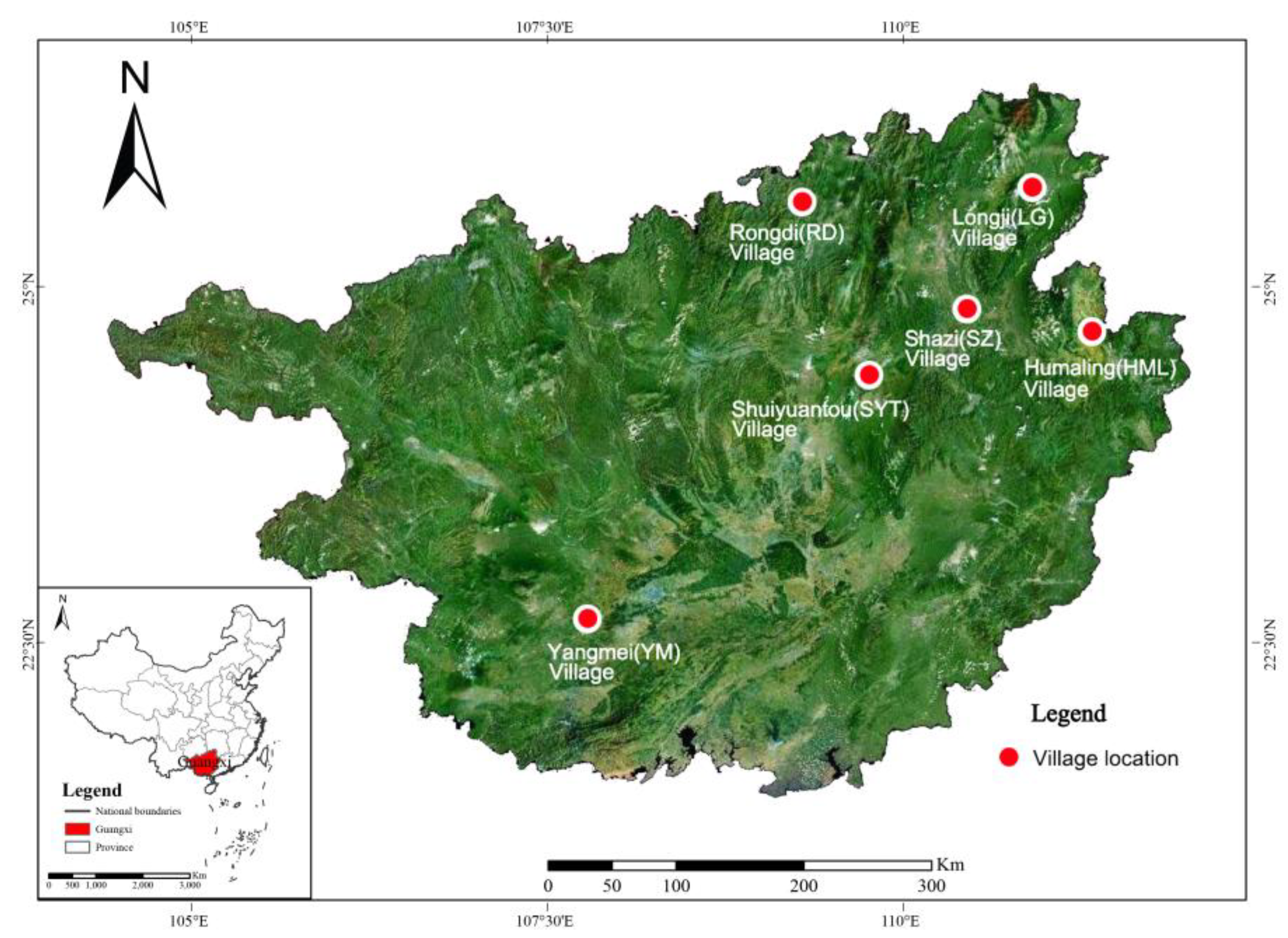
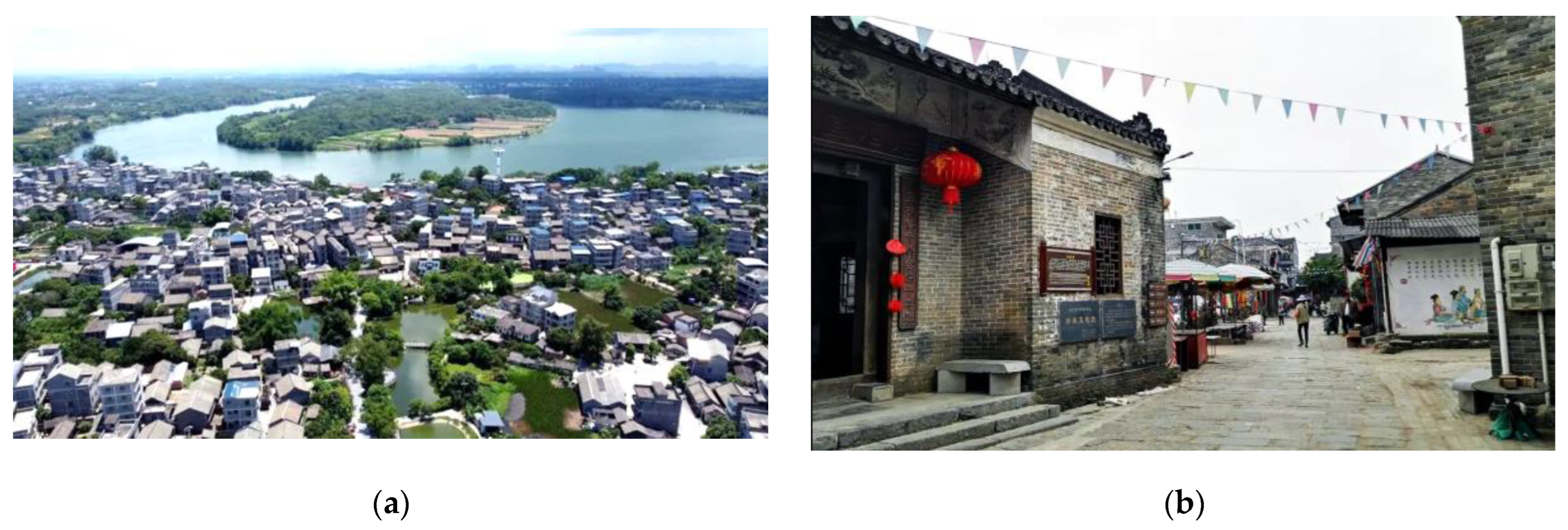
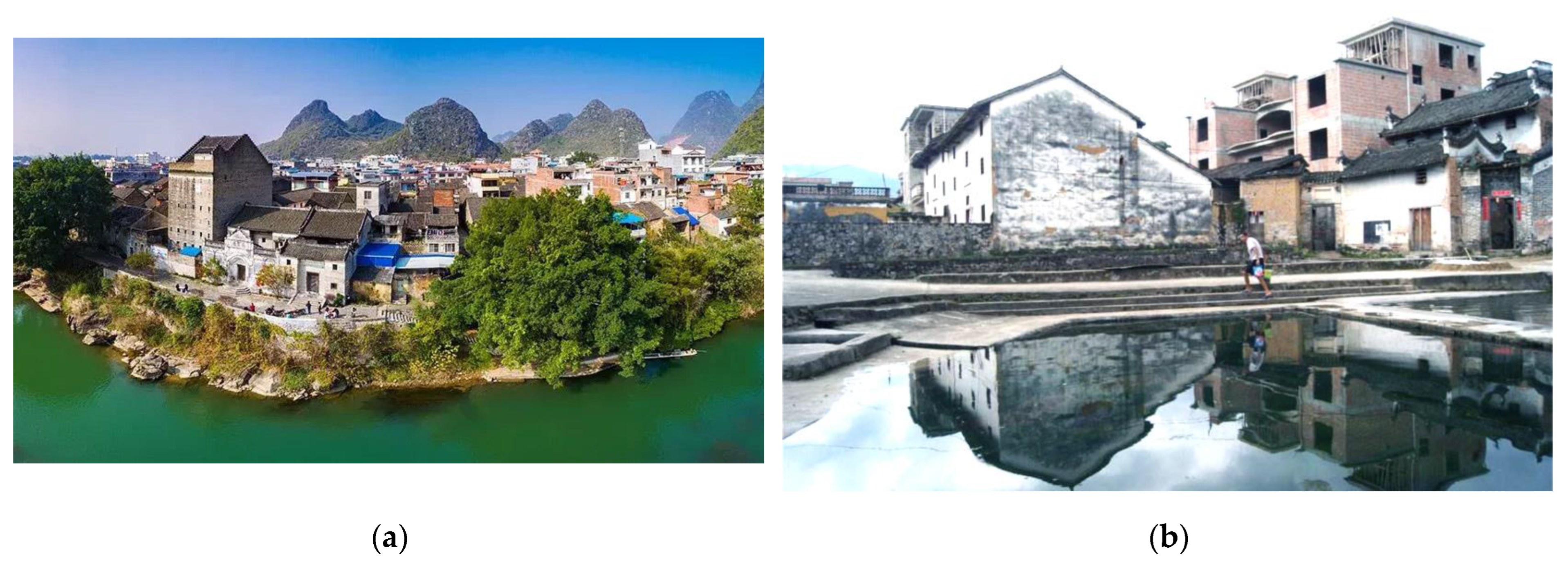
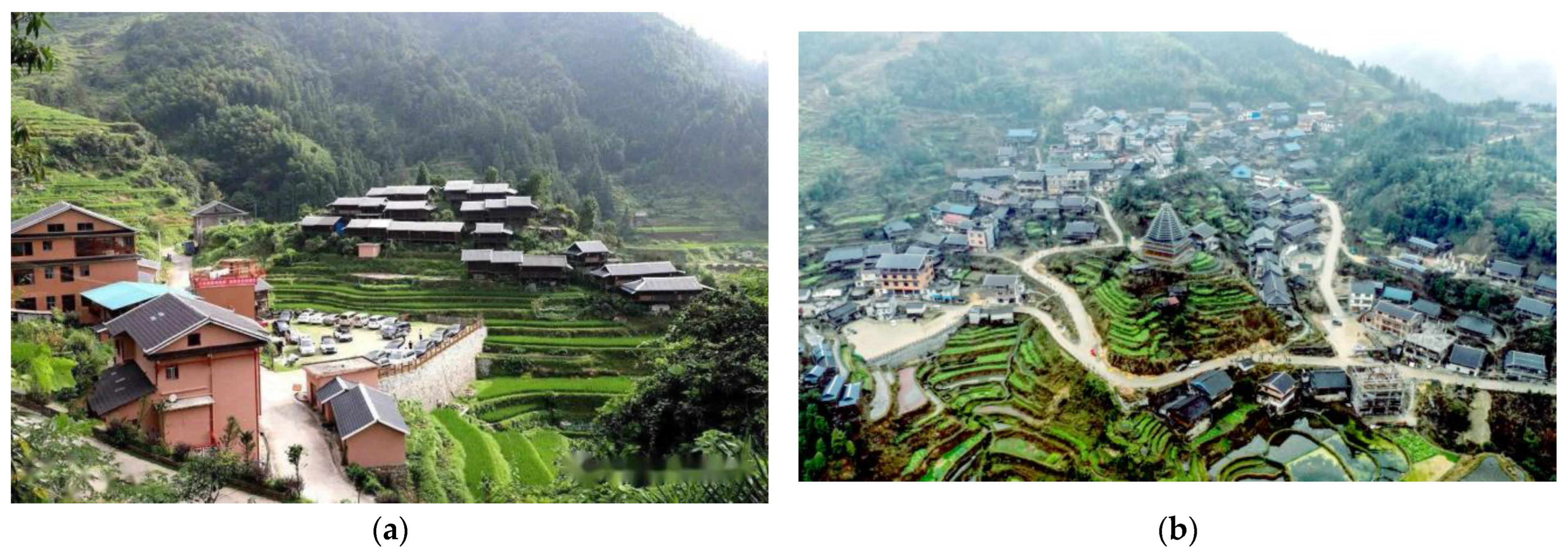

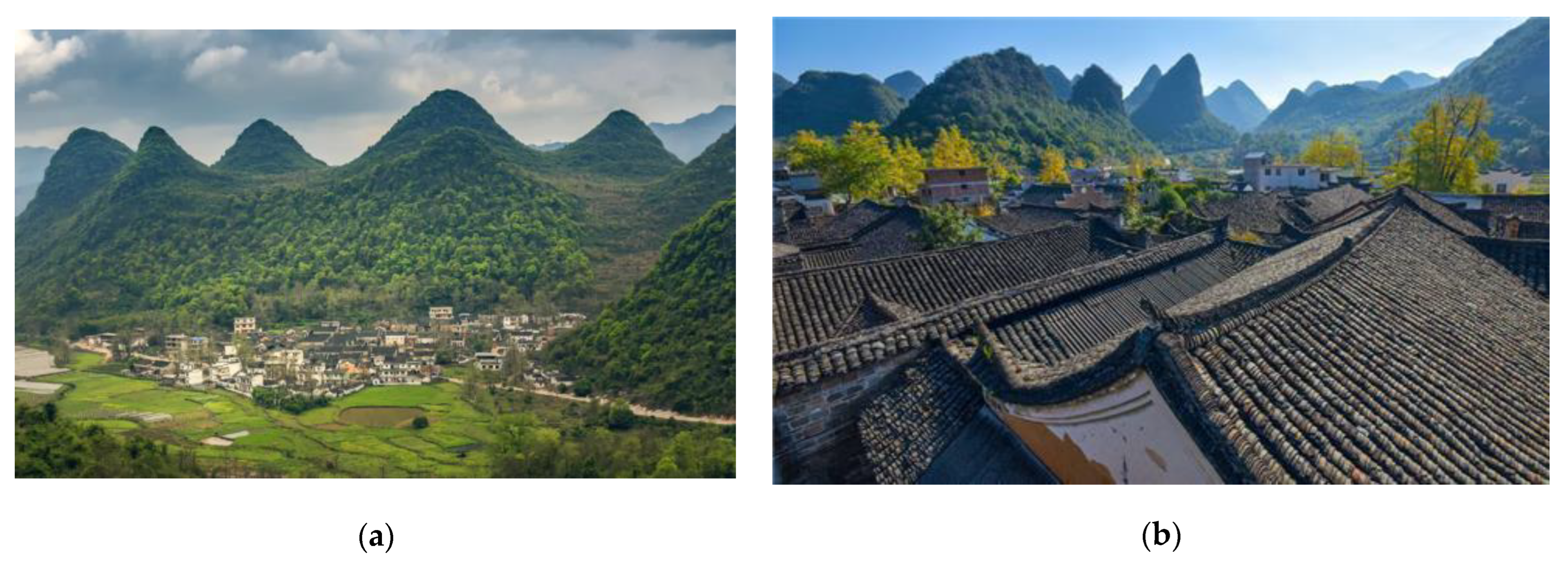
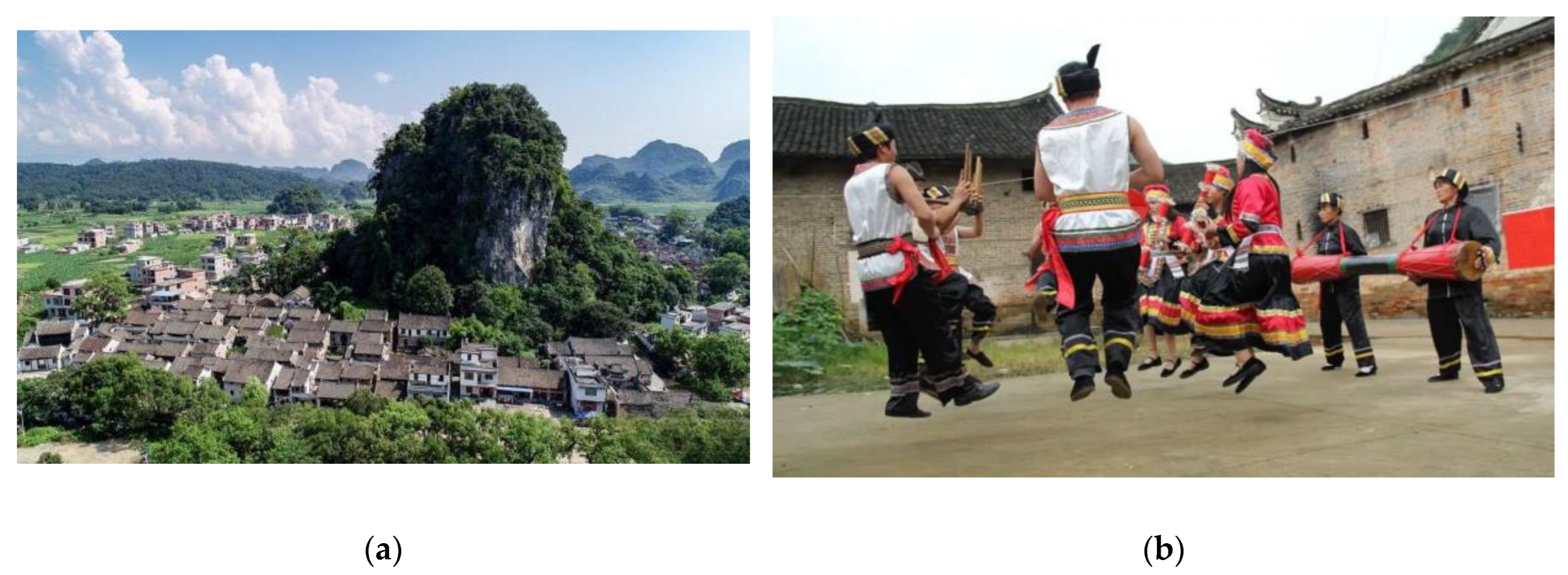
| Village Name | Geographical Position | Type | Information and Characteristics |
|---|---|---|---|
| Longgi | Longji Town, Longsheng County, Guilin City | Alpine slope | The population is 6734 (2021), and the inhabitants are people of the Zhuang minority; the location of the village is relatively high, and the average altitude is 800 m; the industries are mainly agriculture, forestry, mineral resource development, and tourism; the natural and cultural landscapes are rich, and there is the famous Longji Terraced Field Scenic Area. |
| Rongdi | Strong Township, Rongshui County, Liuzhou City | Alpine slope | The population is 1287 (2021), and the inhabitants are people of the Dong minority; the average altitude is 810 m; the industries are mainly agriculture, animal husbandry, forestry, and tourism; the natural landscape resources, ethnic history, and cultural resources are rich. |
| Shuiyuantou | Baishi Township, Xing’an County, Guilin City | Hilly valley | The population is 416 (2021), and the inhabitants are people of the Han nationality; the average altitude is 250 m; there are large-scale building complexes; the industry is mainly based on agriculture and tourism; the historical and cultural landscape is rich, and there is the famous Qin Family Courtyard scenic spot. |
| Humaling | Xinhua Township, Fuchuan County, Hezhou City | Hilly valley | The population is 496 (2021), and the Yao minority population accounts for the majority of the inhabitants; the geographical location is unique; the average altitude is 320 m, at the junction of three provinces; the industry is mainly based on agriculture and aquaculture; Yao dance is included in the list of intangible cultural heritage. |
| Yangmei | Jiangxi Town, Jiangnan District, Nanning City | Plain waterfront | The population is 5042 (2021), and the Han nationality population accounts for the majority of the inhabitants; the average altitude is 70 m; it is surrounded by rivers on three sides (Zuojiang, Youjiang, and Yongjiang) and has eight wharves; the industries are mainly agriculture, aquaculture, and tourism; the historical and cultural landscape is outstanding. |
| Shazi | Shazi Town, Pingle County, Guilin City | Plain waterfront | The geographical position is superior, with a population of 480 (2021); the average altitude is 100 m; it is located at the junction of three counties, with highly convenient land and water transportation. The village is situated in the back of the mountains and faces the water. The industries are mainly agriculture, handicrafts, and commerce. The town has many historical streets and traditional buildings. |
| Layer B | Weight | Layer C | Weight | Layer D | Weight | Layer C | Weight | Layer D | Weight |
|---|---|---|---|---|---|---|---|---|---|
| B1 | 0.45 | C1 | 0.1319 | D1 | 0.0093 | C5 | 0.0331 | D18 | 0.0102 |
| D2 | 0.0369 | D19 | 0.0061 | ||||||
| D3 | 0.0118 | D20 | 0.0077 | ||||||
| D4 | 0.0157 | D21 | 0.0091 | ||||||
| D5 | 0.0145 | C6 | 0.0256 | D22 | 0.0058 | ||||
| D6 | 0.0437 | D23 | 0.0121 | ||||||
| C2 | 0.0309 | D7 | 0.0098 | D24 | 0.0029 | ||||
| D8 | 0.0117 | D25 | 0.0048 | ||||||
| D9 | 0.0094 | ||||||||
| C3 | 0.0608 | D10 | 0.0176 | C7 | 0.0853 | D26 | 0.0376 | ||
| D11 | 0.0231 | D27 | 0.0094 | ||||||
| D12 | 0.0103 | D28 | 0.0179 | ||||||
| D13 | 0.0098 | D29 | 0.0204 | ||||||
| C4 | 0.0388 | D14 | 0.0073 | C8 | 0.0436 | ||||
| D15 | 0.0124 | D30 | 0.0134 | ||||||
| D16 | 0.0108 | D31 | 0.0201 | ||||||
| D17 | 0.0083 | D32 | 0.0101 | ||||||
| B2 | 0.35 | C9 | 0.077 | D33 | 0.013 | C11 | 0.3675 | D41 | 0.1398 |
| D34 | 0.0161 | D42 | 0.033 | ||||||
| D35 | 0.0154 | D43 | 0.1249 | ||||||
| D36 | 0.0325 | D44 | 0.0698 | ||||||
| C10 | 0.0945 | D37 | 0.0321 | ||||||
| D38 | 0.0199 | ||||||||
| D39 | 0.034 | ||||||||
| D40 | 0.0085 | ||||||||
| B3 | 0.2 | C12 | 0.088 | D45 | 0.0097 | C14 | 0.048 | ||
| D46 | 0.0203 | D56 | 0.0172 | ||||||
| D47 | 0.0088 | D57 | 0.0128 | ||||||
| D48 | 0.0281 | D58 | 0.0062 | ||||||
| D49 | 0.0062 | D59 | 0.0116 | ||||||
| D50 | 0.0149 | ||||||||
| C13 | 0.064 | D51 | 0.0231 | ||||||
| D52 | 0.0153 | ||||||||
| D53 | 0.0071 | ||||||||
| D54 | 0.01 | ||||||||
| D55 | 0.0085 |
| Layer B | Score | Layer C | Score | Layer D | Score | Weight | |||||||||||||||
|---|---|---|---|---|---|---|---|---|---|---|---|---|---|---|---|---|---|---|---|---|---|
| LG | RD | SYT | HML | YM | SZ | LG | RD | SYT | HML | YM | SZ | LG | RD | SYT | HML | YM | SZ | ||||
| B1 | 32.416 | 22.766 | 31.344 | 24.39 | 36.758 | 28.512 | C1 | 11.032 | 7.306 | 11.324 | 8.792 | 12.954 | 9.898 | D1 | 0.186 | 0.186 | 0.744 | 0.744 | 0.93 | 0.93 | 0.0093 |
| D2 | 3.69 | 2.214 | 3.69 | 2.214 | 3.69 | 2.952 | 0.0369 | ||||||||||||||
| D3 | 0.708 | 0.472 | 0.708 | 0.236 | 0.944 | 0.708 | 0.0118 | ||||||||||||||
| D4 | 0.628 | 0.942 | 0.942 | 0.942 | 1.57 | 0.942 | 0.0157 | ||||||||||||||
| D5 | 1.45 | 0.87 | 0.87 | 1.16 | 1.45 | 0.87 | 0.0145 | ||||||||||||||
| D6 | 4.37 | 2.622 | 4.37 | 3.496 | 4.37 | 3.496 | 0.0437 | ||||||||||||||
| C2 | 1.44 | 1.712 | 2.096 | 1.908 | 2.292 | 2.096 | D7 | 0.784 | 0.588 | 0.784 | 0.784 | 0.98 | 0.784 | 0.0098 | |||||||
| D8 | 0.468 | 0.936 | 0.936 | 0.936 | 0.936 | 0.936 | 0.0117 | ||||||||||||||
| D9 | 0.188 | 0.188 | 0.376 | 0.188 | 0.376 | 0.376 | 0.0094 | ||||||||||||||
| C3 | 3.834 | 2.628 | 3.02 | 2.422 | 3.482 | 2.824 | D10 | 1.056 | 0.704 | 0.704 | 0.704 | 0.704 | 0.704 | 0.0176 | |||||||
| D11 | 1.386 | 0.924 | 0.924 | 0.924 | 1.386 | 0.924 | 0.0231 | ||||||||||||||
| D12 | 0.412 | 0.412 | 0.412 | 0.206 | 0.412 | 0.412 | 0.0103 | ||||||||||||||
| D13 | 0.98 | 0.588 | 0.98 | 0.588 | 0.98 | 0.784 | 0.0098 | ||||||||||||||
| C4 | 3.498 | 3.498 | 3.136 | 3.282 | 3.282 | 3.282 | D14 | 0.73 | 0.73 | 0.584 | 0.73 | 0.73 | 0.73 | 0.0073 | |||||||
| D15 | 1.24 | 1.24 | 1.24 | 1.24 | 1.24 | 1.24 | 0.0124 | ||||||||||||||
| D16 | 0.864 | 0.864 | 0.648 | 0.648 | 0.648 | 0.648 | 0.0108 | ||||||||||||||
| D17 | 0.664 | 0.664 | 0.664 | 0.664 | 0.664 | 0.664 | 0.0083 | ||||||||||||||
| C5 | 1.12 | 1.324 | 1.628 | 1.528 | 2.24 | 2.058 | D18 | 0.204 | 0.408 | 0.408 | 0.612 | 1.02 | 1.02 | 0.0102 | |||||||
| D19 | 0.244 | 0.244 | 0.366 | 0.244 | 0.366 | 0.366 | 0.0061 | ||||||||||||||
| D20 | 0.308 | 0.308 | 0.308 | 0.308 | 0.308 | 0.308 | 0.0077 | ||||||||||||||
| D21 | 0.364 | 0.364 | 0.546 | 0.364 | 0.546 | 0.364 | 0.0091 | ||||||||||||||
| C6 | 1.874 | 1.266 | 1.42 | 1.44 | 1.778 | 1.778 | D22 | 0.348 | 0.232 | 0.232 | 0.348 | 0.348 | 0.348 | 0.0058 | |||||||
| D23 | 0.968 | 0.726 | 0.726 | 0.726 | 0.968 | 0.968 | 0.0121 | ||||||||||||||
| D24 | 0.174 | 0.116 | 0.174 | 0.174 | 0.174 | 0.174 | 0.0029 | ||||||||||||||
| D25 | 0.384 | 0.192 | 0.288 | 0.192 | 0.288 | 0.288 | 0.0048 | ||||||||||||||
| C7 | 8.342 | 3.958 | 5.902 | 3.944 | 7.778 | 4.898 | D26 | 3.76 | 1.504 | 2.256 | 2.256 | 3.008 | 2.256 | 0.0376 | |||||||
| D27 | 0.752 | 0.564 | 0.94 | 0.564 | 0.94 | 0.752 | 0.0094 | ||||||||||||||
| D28 | 1.79 | 1.074 | 1.074 | 0.716 | 1.79 | 1.074 | 0.0179 | ||||||||||||||
| D29 | 2.04 | 0.816 | 1.632 | 0.408 | 2.04 | 0.816 | 0.0204 | ||||||||||||||
| C8 | 1.276 | 1.074 | 2.818 | 1.074 | 2.952 | 1.678 | D30 | 0.268 | 0.268 | 0.804 | 0.268 | 0.536 | 0.268 | 0.0134 | |||||||
| D31 | 0.402 | 0.402 | 1.206 | 0.402 | 1.608 | 0.804 | 0.0201 | ||||||||||||||
| D32 | 0.606 | 0.404 | 0.808 | 0.404 | 0.808 | 0.606 | 0.0101 | ||||||||||||||
| B2 | 23.12 | 22.382 | 30.064 | 21.102 | 35.702 | 32.398 | C9 | 2.58 | 2.58 | 5.12 | 5.12 | 6.092 | 6.092 | D33 | 1.3 | 1.3 | 1.3 | 1.3 | 1.3 | 1.3 | 0.013 |
| D34 | 0.322 | 0.322 | 1.288 | 1.288 | 1.61 | 1.61 | 0.0161 | ||||||||||||||
| D35 | 0.308 | 0.308 | 1.232 | 1.232 | 1.232 | 1.232 | 0.0154 | ||||||||||||||
| D36 | 0.65 | 0.65 | 1.3 | 1.3 | 1.95 | 1.95 | 0.0325 | ||||||||||||||
| C10 | 5.84 | 5.102 | 6.35 | 3.78 | 7.56 | 6.312 | D37 | 1.926 | 1.926 | 1.926 | 1.284 | 2.568 | 2.568 | 0.0321 | |||||||
| D38 | 1.194 | 0.796 | 1.194 | 0.796 | 1.592 | 1.194 | 0.0199 | ||||||||||||||
| D39 | 2.04 | 2.04 | 2.72 | 1.36 | 2.72 | 2.04 | 0.034 | ||||||||||||||
| D40 | 0.68 | 0.34 | 0.51 | 0.34 | 0.68 | 0.51 | 0.0085 | ||||||||||||||
| C11 | 14.7 | 14.7 | 18.594 | 12.202 | 22.05 | 19.994 | D41 | 5.592 | 5.592 | 5.592 | 5.592 | 8.388 | 8.388 | 0.1398 | |||||||
| D42 | 1.32 | 1.32 | 1.32 | 1.32 | 1.98 | 1.32 | 0.033 | ||||||||||||||
| D43 | 4.996 | 4.996 | 7.494 | 2.498 | 7.494 | 7.494 | 0.1249 | ||||||||||||||
| D44 | 2.792 | 2.792 | 4.188 | 2.792 | 4.188 | 2.792 | 0.0698 | ||||||||||||||
| B3 | 11.318 | 9.74 | 12.19 | 10.36 | 14.002 | 11.46 | C12 | 6.566 | 6.424 | 6.582 | 6.582 | 7.108 | 6.352 | D45 | 0.97 | 0.776 | 0.582 | 0.582 | 0.776 | 0.582 | 0.0097 |
| D46 | 1.624 | 1.624 | 1.624 | 1.624 | 1.218 | 1.218 | 0.0203 | ||||||||||||||
| D47 | 0.176 | 0.352 | 0.704 | 0.704 | 0.88 | 0.88 | 0.0088 | ||||||||||||||
| D48 | 1.686 | 1.686 | 1.686 | 1.686 | 2.248 | 1.686 | 0.0281 | ||||||||||||||
| D49 | 0.62 | 0.496 | 0.496 | 0.496 | 0.496 | 0.496 | 0.0062 | ||||||||||||||
| D50 | 1.49 | 1.49 | 1.49 | 1.49 | 1.49 | 1.49 | 0.0149 | ||||||||||||||
| C13 | 2.08 | 1.28 | 2.972 | 1.742 | 3.878 | 2.816 | D51 | 0.462 | 0.462 | 1.848 | 0.924 | 1.848 | 1.386 | 0.0231 | |||||||
| D52 | 0.306 | 0.306 | 0.612 | 0.306 | 0.918 | 0.918 | 0.0153 | ||||||||||||||
| D53 | 0.142 | 0.142 | 0.142 | 0.142 | 0.142 | 0.142 | 0.0071 | ||||||||||||||
| D54 | 1 | 0.2 | 0.2 | 0.2 | 0.8 | 0.2 | 0.01 | ||||||||||||||
| D55 | 0.17 | 0.17 | 0.17 | 0.17 | 0.17 | 0.17 | 0.0085 | ||||||||||||||
| C14 | 2.672 | 2.036 | 2.636 | 2.036 | 3.016 | 2.292 | D56 | 0.688 | 0.688 | 1.032 | 0.688 | 1.032 | 0.688 | 0.0172 | |||||||
| D57 | 1.024 | 0.512 | 0.768 | 0.512 | 1.024 | 0.768 | 0.0128 | ||||||||||||||
| D58 | 0.496 | 0.372 | 0.372 | 0.372 | 0.496 | 0.372 | 0.0062 | ||||||||||||||
| D59 | 0.464 | 0.464 | 0.464 | 0.464 | 0.464 | 0.464 | 0.0116 | ||||||||||||||
| Amount | 66.854 | 54.888 | 73.598 | 55.852 | 86.462 | 72.37 | Amount | 66.854 | 54.888 | 73.598 | 55.852 | 86.462 | 72.37 | Amount | 66.854 | 54.888 | 73.598 | 55.852 | 86.462 | 72.37 | 1 |
| Category | Level | Material Heritage | Intangible Heritage | Value |
|---|---|---|---|---|
| Living space | First-order space | Folk houses; ancestral halls; gatehouses; archways; puddles; stage; temples; streets; drum towers; ancient trees; famous trees; ancient wells; sundecks; ferry; wharf | The national language; folk literature; folk art, folk music; folk dance; opera; folk art; folk acrobatics; life etiquette and customs; traditional sports | Core |
| Production space | Secondary space | Palace temple; Wind and Rain bridge; farmland; garden; pasture; grassland; workshop; mill; ditch | Traditional handicrafts; farming culture; Traditional medicine; production; trade customs | Domain |
| Ecological Space | Three-level spatial | Mountain; water; river; lake; terrace; landscape forest; “Feng Shui” forest | Folk beliefs; ecological living; folk customs; folk knowledge | Boundary |
Disclaimer/Publisher’s Note: The statements, opinions and data contained in all publications are solely those of the individual author(s) and contributor(s) and not of MDPI and/or the editor(s). MDPI and/or the editor(s) disclaim responsibility for any injury to people or property resulting from any ideas, methods, instructions or products referred to in the content. |
© 2023 by the authors. Licensee MDPI, Basel, Switzerland. This article is an open access article distributed under the terms and conditions of the Creative Commons Attribution (CC BY) license (https://creativecommons.org/licenses/by/4.0/).
Share and Cite
Lu, Y.; Ahmad, Y. Heritage Protection Perspective of Sustainable Development of Traditional Villages in Guangxi, China. Sustainability 2023, 15, 3387. https://doi.org/10.3390/su15043387
Lu Y, Ahmad Y. Heritage Protection Perspective of Sustainable Development of Traditional Villages in Guangxi, China. Sustainability. 2023; 15(4):3387. https://doi.org/10.3390/su15043387
Chicago/Turabian StyleLu, Yong, and Yahaya Ahmad. 2023. "Heritage Protection Perspective of Sustainable Development of Traditional Villages in Guangxi, China" Sustainability 15, no. 4: 3387. https://doi.org/10.3390/su15043387
APA StyleLu, Y., & Ahmad, Y. (2023). Heritage Protection Perspective of Sustainable Development of Traditional Villages in Guangxi, China. Sustainability, 15(4), 3387. https://doi.org/10.3390/su15043387








